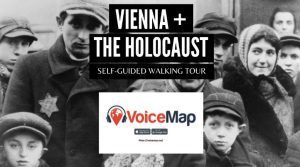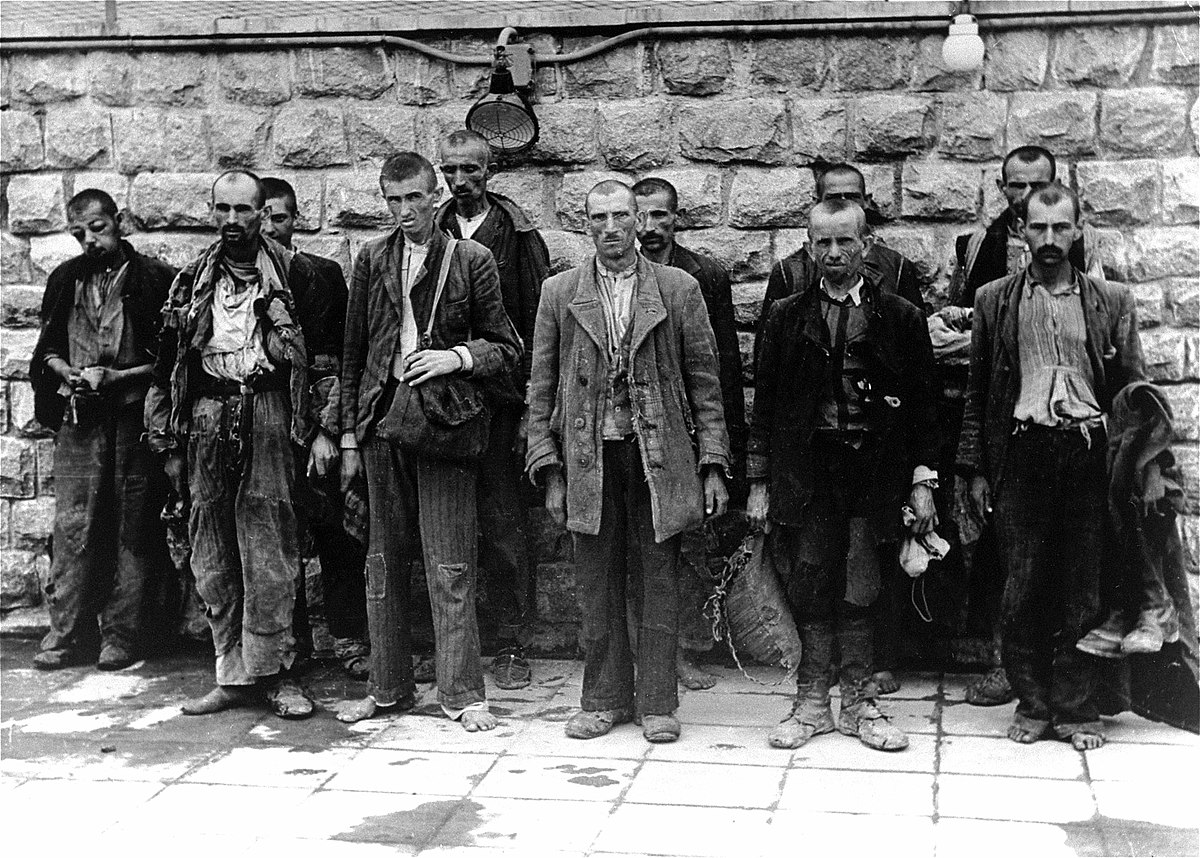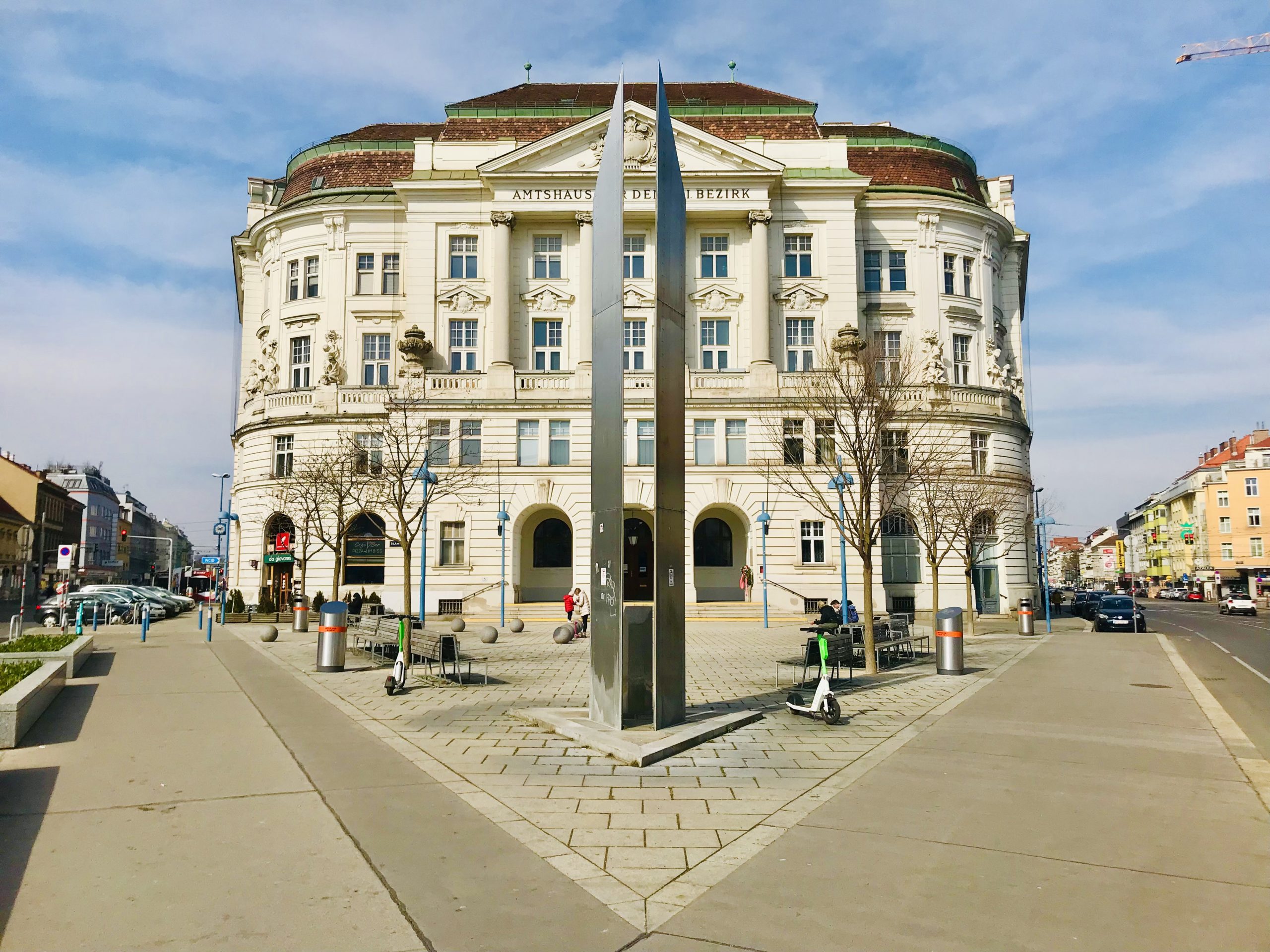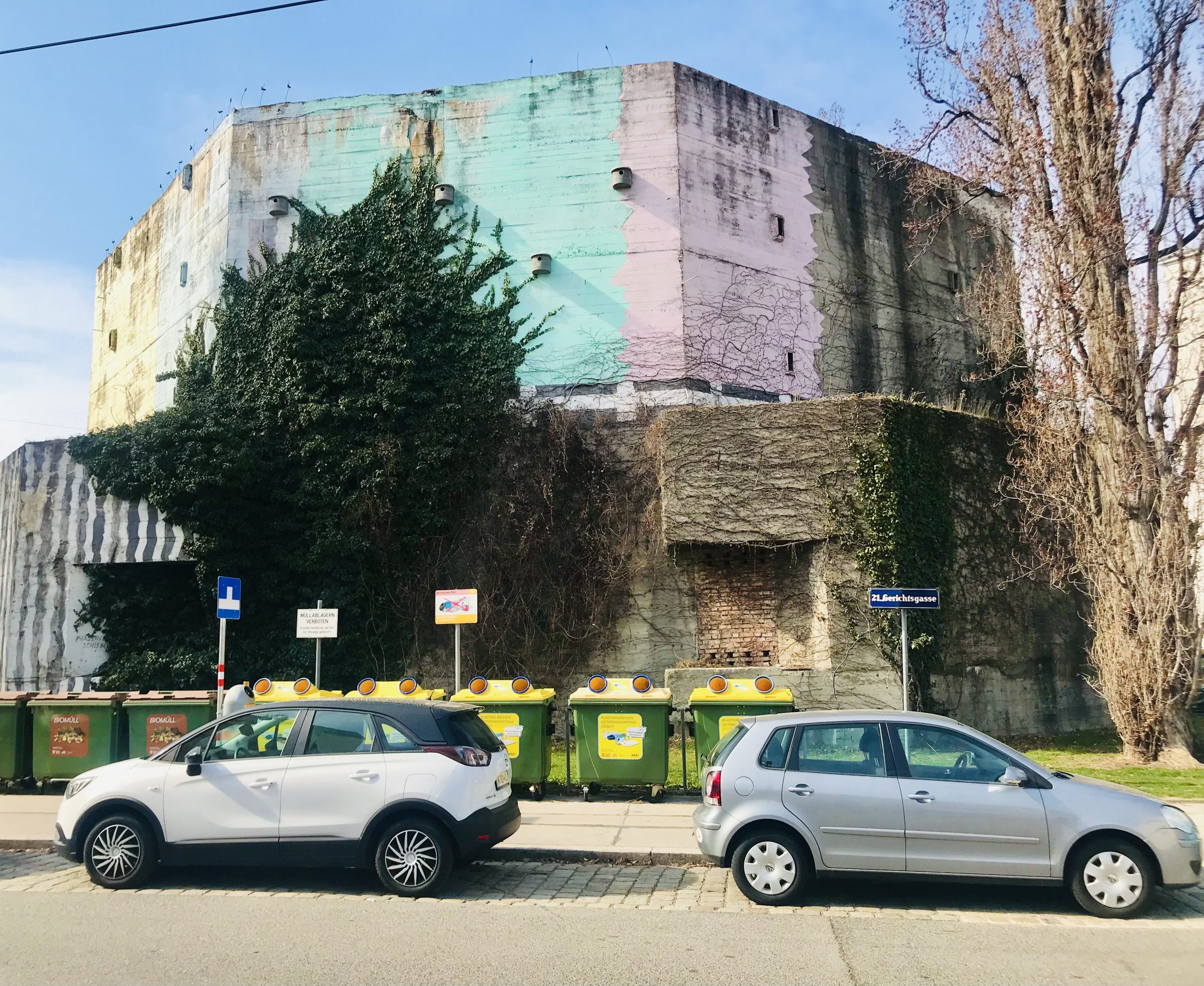
PURE EVIL WAS ON TRIAL IN COURTROOM 600 OF THE PALACE OF JUSTICE IN NUREMBERG
Table of Contents
- 1 THE MOST FAMOUS COURTROOM IN THE WORLD
- 2 MAJOR WAR CRIMINALS TRIAL AT THE PALACE OF JUSTICE IN NUREMBERG
- 3 SUBSEQUENT TRIALS AT THE PALACE OF JUSTICE IN NUREMBERG
- 4 OUR EXPERIENCE AT THE PALACE OF JUSTICE IN NUREMBERG
- 5 PRO TIPS FOR VISITING THE PALACE OF JUSTICE IN NUREMBERG
- 6 NEAR THIS PLACE
- 7 RELATED TOPICS
- 8 BEST PLACES TO STAY
- 9 BOOKSHELF
- 10 TV + FILM
- 11
Once hailed as a Führer city, Nuremberg served as the backdrop for the final chapter of WW2. 50 million dead. Millions injured. Mass devastation. Crimes against humanity including genocide. These were the charges the Allies levied against 24 leading political and military officials of the Nazi regime. Today, the Palace of Justice in Nuremberg has an extensive exhibit documenting this historical trial. Use our Guide to the Palace of Justice in Nuremberg to make the most of your visit.
Between 20 November 1945 and 1 October 1946, the surviving Nazi leaders had to answer for their crimes before an International Military Tribunal. Another 177 high-ranking Germans faced follow-up trials. The Palace of Justice in Nuremberg was chosen as the location of the trials. It was relatively undamaged from the War, afforded ample space, and had a large prison complex. As the birthplace of the Nazi Party, Nuremberg was a symbolic choice. Ironically, Nuremberg would also be where the Party would meet its end.
THE MOST FAMOUS COURTROOM IN THE WORLD
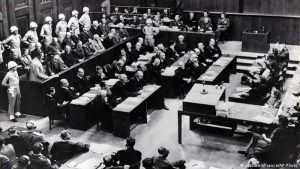 wikimedia commons
wikimedia commons
Perhaps one of the most recognized sites associated with WW2, the trials took place in courtroom 600 in the eastern wing of the Palace of Justice in Nuremberg. During the Nuremberg Trials, the entire world learned for the first time about the German atrocities.
MODIFICATIONS FOR PRESS COVERAGE
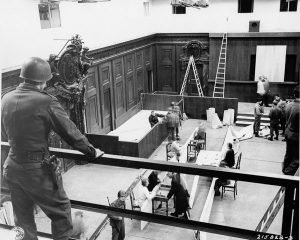
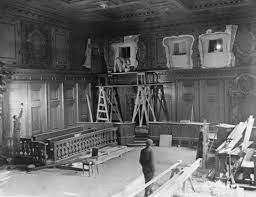 wikimedia commons
wikimedia commons
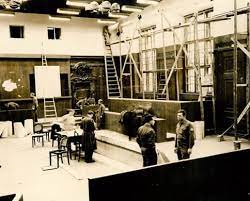 guardian.co.uk
guardian.co.uk
In 1945, space had to be created in the courtroom for the judges, translators, members of the press, and for the defendants. Walls were removed, the judges’ bench was turned 90 degrees and was relocated in front of a window, and the witness box was moved. The entire trial was captured on film and broadcast to the world on television.
Major modifications to the courtroom were made to accommodate the almost five years of trials. Small rooms with holes in the wall were created around the top of the room. Photographers and filmmakers occupied these rooms. Special lighting was installed in the courtroom so that flash bulbs were not needed.
THE EXHIBIT “MEMORIAM NUREMBERG TRIALS”
In November 2010, a permanent exhibit dubbed the Memorium Nuremberg Trials was opened in the Palace of Justice. This extensive exhibit focuses on all aspects of the Trials including the evidence presented, the convictions, and the prominent Nazi leaders who planned or assisted in the Holocaust and other war crimes.
There are a number of multimedia displays that explain the different events that led up to the tribunals, as well as the legal proceedings that occurred in Courtroom 600. Of interest, there are two benches from the defendants “dock” on display.
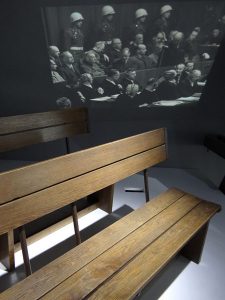 wikimedia commons
wikimedia commons
Learn more about Courtroom 600 here:
THEN AND NOW
Although the Palace of Justice in Nuremberg remains quite recognizable today, the courtroom was refurbished following the Trials. As recently as 1 March 2020, the most famous courtroom in the world was still in use, primarily for murder trials.
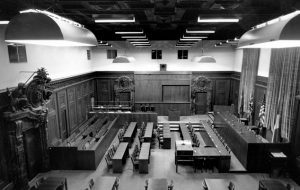
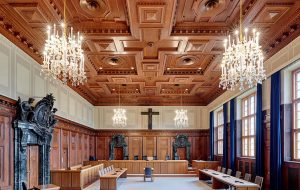 museums.nuremberg.de
museums.nuremberg.de
MAJOR WAR CRIMINALS TRIAL AT THE PALACE OF JUSTICE IN NUREMBERG
The Nuremberg trials were conducted in accordance with international law and the laws of war. The trials were most notable for the prosecution of prominent members of the political, military, judicial, and economic leadership of Nazi Germany. These were the individuals who planned, carried out, or otherwise participated in the Holocaust and committed other heinous war crimes.
THE 24 DEFENDENTS
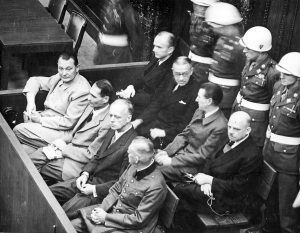
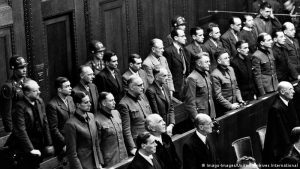 wikimedia commons
wikimedia commons
Between 20 November 1945 and 1 October 1946, the International Military Tribunal was given the task of trying 24 of the most important political and military leaders of the Third Reich. 12 of the defendants were sentenced to death by hanging, three were acquitted, seven received prison sentences, one was tried in a separate trial, and one committed suicide before the Trials began. There were separate trials held for Nazi Doctors and Judges.
THE ALLIES
The three major Allied powers, the United States, the United Kingdom, and the Soviet Union agreed on the format of punishment for those responsible for war crimes during WW2. France was also granted a seat on the tribunal. The Allies restricted the trial to the “punishment of the major war criminals of the European Axis countries.”
200 German defendants were tried in the Palace of Justice in Nuremberg and 1600 others were tried by traditional military courts. The legal basis for the jurisdiction of the court was justified under the Instrument of Surrender of Germany. Interestingly, because the court was limited to violations of the laws of war, it did not have jurisdiction over crimes that took place before the outbreak of war on 1 September 1939.
Joseph Stalin (1878-1953), the Soviet leader, initially proposed the execution of 50,000 to 100,000 German staff officers. British Prime Minister Winston Churchill (1874-1965) discussed the possibility of summary execution (execution without a trial) of high-ranking Nazis but was persuaded by American leaders that a criminal trial would be more effective.
THE JUDGES
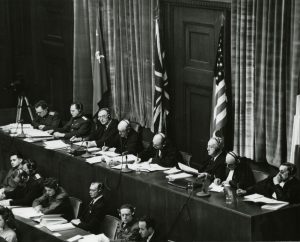
The International Military Tribunal was opened on 19 November 1945 in the Palace of Justice in Nuremberg. Soviet judge Nikitchenko presided over the opening session. President Harry S Truman appointed Roosevelt’s former attorney general Francis Biddle as the U.S. judge for the Nuremberg trial.
The prosecution entered indictments against 24 major war criminals and seven organizations –- the leadership of the Nazi party, the Reich Cabinet, the Schutzstaffel (SS), Sicherheitsdienst (SD), the Gestapo, the Sturmabteilung (SA) and the General Staff and High Command.
LOGISTICS
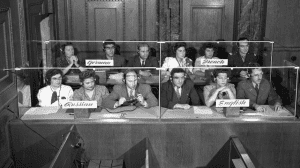 abc.com
abc.com
As the defendants and judges spoke four different languages (English, French, German and Russian), instantaneous translation was a critical requirement for the trials to be successful. IBM provided equipment and recruited men and women from international telephone exchanges to provide instantaneous translations through headphones.
THE CRIMES
The senior leadership of the Nazi regime – both political and military – were indicted for:
- Participation in a common plan or conspiracy for the accomplishment of a crime against peace;
- Planning, initiating and waging wars of aggression and other crimes against peace;
- Participating in War crimes; and
- Crimes against humanity
ESCAPING JUSTICE
Although a number of well-known figures of the Nazi regime were captured and tried, sadly the following senior and most culpable members of the regime escaped justice:
- Adolf Hitler. To avoid capture by the Soviets, Hitler committed suicide in the Führer bunker on 30 April 1945 along with his mistress Eva Braun.
- Hermann Göring. Effectively second in command, Reichsmarschall Hermann Göring was captured by the U.S. military while attempting to escape. He was sentenced to death but committed suicide by swallowing potassium cyanide the night before his execution.
- Heinrich Himmler. Reichsführer Heinrich Himmler was an architect of the Holocaust and was in charge of the feared SS and Gestapo. Rejected by his former Nazi comrades and hunted by the Allies, Himmler fled and attempted to go into hiding in northern Germany. On 21 May 1945, Himmler and two aides were stopped and detained at a checkpoint set up by former Soviet POWs. He was transferred into British custody on 23 May. During a routine interrogation, Himmler acknowledged his identity. Himmler was taken to the Lüneburg, where a British military doctor conducted a medical exam on him. When the doctor attempted to examine the inside of Himmler’s mouth, he was reluctant to open it and jerked his head away. Himmler had bitten a hidden potassium cyanide pill and collapsed. Within 15 minutes he was dead. Himmler was buried in an unmarked grave near Lüneburg.
- Joseph Goebbels. Reich Minister of Propaganda Joseph Goebbels committed suicide in the Führer bunker with his wife Magda on 30 April 1945. Before killing themselves, he and his wife poisoned their six children.
- Heinrich Müller. The former Gestapo Chief disappeared the day after Hitler’s suicide on 1 May 1945. He is the most senior figure of the Nazi regime whose fate remains unknown.
- Reinhard Heydrich. Regarded as the darkest figure in the Nazi regime, Heydrich was one of the main architects of the Holocaust. He was the Chief of the Reich Main Security Office which included the Gestapo and SD. Heydrich personally oversaw the Nazi occupation of Bohemia and Moravia. Heydrich was assassinated by Czech partisans in 1942.
- Adolf Eichmann. Eichmann oversaw the forced removal of Jews from Nazi-occupied territories including Austria, Poland, the Czech Republic, and Hungary. At the end of WW2, he fled to Argentina to avoid capture. Eichmann was an unknown entity until the Nuremberg Trials when he was named repeatedly as the architect of the Holocaust. Eichmann was captured in Argentina by the Mossad during a daring operation. He was afforded a fair trial in Israel to answer for his crimes and was sentenced to death by hanging in 1962.
- Martin Bormann. Adolf Hitler’s most trusted henchman was Nazi Party Secretary Martin, Bormann. As the personal Secretary to the Führer, Bormann controlled the flow of information and all physical access to Hitler. He also managed Hitler’s finances and property. In the final moments of WW2, Bormann fled the Führer bunker in Berlin with the Head of the Hitler Youth Artur Axemann. According to accounts, Bormann was killed by the Russians during their attack on Berlin but his body was never found. As such, Bormann received a death sentence in absentia during the Nuremberg Trials. In 1963, a retired postal worker in Berlin named Albert Krumnow told police that around 8 May 1945 the Soviet troops had ordered him and his colleagues to bury two bodies found near the railway bridge near Lehrter train station. Bormann’s body was recovered in 1972 near this site. He was cremated and his ashes scattered into the Baltic Sea.
- Rudolph Hess. Bormann succeeded Hitler’s Deputy Führer Rudolph Hess when in 1941, Hess flew to Scotland in an attempt to broker peace with the United Kingdom. Hess was arrested by the British authorities, interrogated, and imprisoned at the Tower of London. Hess received a sentence of life imprisonment at Spandau Prison. Hess, who was the lone prisoner at Spandau, remained incarcerated until his suicide in 1987.
- Robert Ley. An ardent anti-semite, Ley was in charge of the National Socialists German Workers Party. He committed suicide one week before the Nuremberg Trials began. He was indicted but was neither acquitted nor found guilty since his trial did not proceed.
SUBSEQUENT TRIALS AT THE PALACE OF JUSTICE IN NUREMBERG
The legal prosecution of Nazi crimes in Germany did not end with the announcement of the verdicts in the Major War Criminals Trial. In addition to the senior leaders of the Nazi regime, U.S. military tribunals held 12 other trials at the Palace of Justice in Nuremberg. Unlike the Major War Criminals Trial, these subsequent trials received less publicity.
These trials were held between 1946 and 1949 against 177 high-ranking physicians, judges, industrialists, SS commanders and police commanders, military personnel, civil servants, and diplomats. The trials revealed the extent to which the German leadership class supported the power system of the Nazi dictatorship.
Of the 177 defendants, 24 received death sentences (13 of the 24 were executed), 20 were sentenced to life imprisonment, and 98 received longer-term prison sentences. 25 defendants were found not guilty. In the 1950s, several former Nazis were pardoned and released from prison.
The other trials were as follows:
- Doctors’ Trial
- Milch Trial
- Judges’ Trial
- Pohl Trial
- Flick Trial
- IG-Farben Trial
- Hostages Trial
- RuSHA Trial
- Einsatzgruppen Trial
- Krupp Trial
- Wilhelmstrasse Trial
- High Command Trial
THE DOCTORS’ TRIAL
During the Doctors’ Trial, the courts tried 23 German medical officials. 20 of the 23 defendants were medical doctors. The defendants were accused of having been involved in Nazi human experimentation and mass murder under the guise of euthanasia. Of the 23 defendants, seven were acquitted and seven received death sentences; the remainder received prison sentences ranging from 10 years to life imprisonment.
- Josef Mengele, known as the “Angel of Death” among Holocaust survivors, was one of the leading Nazi doctors involved in these gruesome crimes against humanity. Mengele evaded capture and fled to Argentina, Paraguay and then Brazil. Aggressively hunted by the Mossad, he drowned in 1979 after suffering a stroke while swimming in the ocean. Mengele was buried under the false name of Wolfgang Gerhard. His remains were disinterred and positively identified by forensic examination in 1985.
THE JUDGES’ TRIAL
U.S. military courts also tried 16 German defendants from the Nazi legal system. Nine defendants were officials from the Reich Ministry of Justice. The others were prosecutors and judges of the Special Courts and People’s Courts. The defendants were accused of implementing and furthering the Nazi racial purity efforts through eugenic and racial laws.
Four defendants were sentenced to life imprisonment and six received prison sentences of varying lengths. Four defendants were acquitted of all charges. One committed suicide before the trial began and one defendant had a mistrial.
THE KRUPP TRIAL
In the Krupp Trial, 12 former directors of the Krupp Group were accused of developing the armaments used by German military forces. The Krupp Group was accused of actively participating in the Nazi war preparations, and using slave labor in their companies.
The main defendant was Alfried Krupp von Bohlen und Halbach, the CEO of the Krupp Holding and the son of Gustav Krupp von Bohlen und Halbach. One defendant was acquitted and the others received moderate prison sentences.
- Alfried Krupp von Bohlen und Halbach was ordered to sell all his possessions. He denied guilt long after WW2. During WW2, the Krupp Group used nearly 100,000 slave laborers including 23,000 prisoners of war.
EXECUTIONS
Those sentenced to death by the International Military Tribunal were executed on 16 October 1946. The executioners were U.S. Army Master Sergeant John C. Woods and Military policeman Joseph Malta. The method of execution was hanging by the standard drop method instead of a long drop.
The U.S. Army would later deny claims that the drop length was too short, which may have caused the condemned to die slowly from strangulation rather than from a broken neck. However, the fact remains that some of the condemned men choked in agony for 14 to 28 minutes.
“The way I look at this hanging job, somebody has to do it . . . 10 men in 103 minutes. That’s fast work.”
Master Sergeant John C. Woods
The executions took place in the gymnasium within the Palace of Justice complex. This building was demolished in 1983. Rumors persisted that the bodies were taken to Dachau for cremation. In reality, the bodies were cremated in Munich and the ashes were scattered over the Isar River.
French judges suggested that the guilty be executed by a firing squad. Judges argued that the German military officers had violated their military oaths and were not worthy of the more dignified death by shooting. The prisoners receiving jail sentences were incarcerated in Spandau Prison.
OUR EXPERIENCE AT THE PALACE OF JUSTICE IN NUREMBERG
We visited the Nazi Party Rally Grounds in the morning and then took the tram over to the Palace of Justice. We walked two blocks to the Palace and entered to purchase our tickets and acquire audio guides. The audio tour starts on the upper floors of the building and works its way through the complex ending at Courtroom 600.
This extensive exhibit was incredibly thorough and appealed to history buffs as well as those with legal backgrounds. Basically, there was as much or as little information that you could handle.
The best part of the tour was the Courtroom. It was interesting to see the original room where the trial was held. To think that in this room was the first time that more than one country had come together to rule on the outcome of an international trial was eye-opening. Seeing the door the defendants walked through each day and before and after photographs of the courtroom really brought the experience to life.
It was compelling reading about the press coverage and the lengths journalists went to in covering the story. Equally interesting was the lengths the Allies went to ensure that the Trial received global coverage. They tore down walls in the courtroom to make room for the television cameras.
It was here at the Nuremberg trials where it was established that all of humanity would be guarded by an international legal shield and that even a Head of State would be held criminally responsible and punished for aggression and Crimes Against Humanity. The Palace of Justice is a must-see for anyone who wants to try and understand what happened before, during and after WW2.
A twist of irony, the Nazis were obsessive-compulsive in their record keeping. These same detailed records would be used against the defendants in the Nuremberg Trials to prove their culpability. This is perhaps one of the most extensive exhibits we have ever seen. After visiting, we can understand why the name Nuremberg is synonymous with the word “justice.” Overall, our visit to the Palace of Justice was an interesting end to an informative day.
PRO TIPS FOR VISITING THE PALACE OF JUSTICE IN NUREMBERG
PRO TIP 1 – VERY IMPORTANT. Give yourself 2+ hours to fully explore this incredibly thorough exhibit.
PRO TIP 2 – VERY IMPORTANT. Make sure you leave enough time to visit Courtroom 600. It is at the very end of the tour. There are several information panels well worth reading that are located in the hallway outside the Courtroom.
PRO TIP 3 – VERY IMPORTANT. The combo ticket is a fantastic deal. You can cover the Nazi Party Rally Grounds and the Nuremberg Courthouse in one day. That said, you will need to have an early start. To buy yourself extra time, take a taxi or drive between sites. A walk through the walled city of Nuremberg is a nice way to complete your day.
PRO TIP 4. During the Trials, the defendants were incarcerated in a prison connected to the Nuremberg Place of Justice. Today, only one of the old prison’s four wings is still standing. Since it is located on the grounds of the Nuremberg Correctional Facility, it is not open to the public. That said, you can see remnants of the old prison from a window in the exhibition hall.
PRO TIP 5. Unfortunately, there is no cafeteria in the Palace of Justice Nuremberg complex. Thankfully, the Fränkischer Gasthof, a beer garden and restaurant, is within walking distance.
NEAR THIS PLACE
TRAVEL GUIDE | NAZI PARTY RALLY GROUNDS. Our informative Guide to the Nazi Party Rally Grounds provides an efficient way to explore this enormous site where evil was once on display.
TRAVEL GUIDE | ROTHENBURG OB DER TAUBER. Rothenburg, a fairytale Bohemian town of gingerbread buildings surrounded by an impressive medieval wall located along Germany’s Romantic Road.
TRAVEL GUIDE |REGENSBURG. A UNESCO World Heritage Site, Regensburg has the largest preserved medieval old town north of the Alps. Regensburg also has several fine Roman exhibits.
TRAVEL GUIDE | BAMBERG. A UNESCO World Heritage Site, Bamberg is a medieval jewel with an impressive Altes Rathaus (Old Town Hall), and a network of bridges and Old Town.
RELATED TOPICS
VOICEMAP | VIENNA SELF GUIDED WALKING TOUR. Want to learn how the Mossad operation to bring Nazis like Adolf Eichmann to justice originated in Vienna? Check out our VoiceMap self guided walking tour: VIENNA + THE HOLOCAUST: FROM TRAGEDY TO JUSTICE. You can preview it for FREE. Start point is Nestroyplatz on the U1 red line in the 2nd District in Vienna.
BEST PLACES TO STAY
LE MERIDIEN GRAND HOTEL NUREMBERG. Directly opposite Nuremberg Central Station and steps away from the Old Town. Elegant rooms with marble bathrooms and iPod docking stations, sauna, and gym. A great choice for travelers interested in museums, architecture, and atmosphere. ADDRESS: Bahnhofstrasse 1-3, Mitte, 90402 Nuremberg, Germany.
PARK PLAZA NUREMBERG. Newly opened in June 2016 and inspired by Albrecht Dürer and Martin Behaim, the Park Plaza is located in the former home of the Bavarian-American Hotel. Each room features a smartphone. Directly opposite Nuremberg Central Station and steps away from the Old Town. ADDRESS: Bahnhofstraße 5, Mitte, 90402 Nuremberg, Germany.
BIO HOTEL KUNSTQUARTIER. Set in a charming 19th-century building and located in Nürnberg’s Stein district next to the Faber-Castell Art Academy and the Rednitz River. This eco-friendly hotel offers spacious rooms with FREE Wifi and laptop upon request. ADDRESS: Hauptstraße 32-34, 90547 Nuremberg, Germany.
NH COLLECTION NURNBERG CITY. Only a 2-minute walk from the Nuremberg Main Station. Soundproofed rooms with stylish furniture, air conditioning, FREE Wifi, and spa facilities. A great choice for travelers interested in museums, architecture, and atmosphere. ADDRESS: Bahnhofstrasse 17 – 19, Mitte, 90402 Nuremberg, Germany.
ADINA APARTMENT HOTEL NUREMBERG. Centrally located apartments and studios with air conditioning, indoor pool, sauna, fitness center, and FREE Wifi. All units are accessible for the physically disabled. ADDRESS: Dr.-Kurt-Schumacher-Straße 1-7, Mitte, 90402 Nuremberg, Germany.
BOOKSHELF
TV + FILM
![]()



